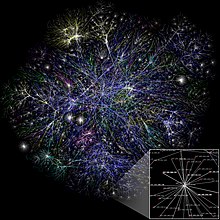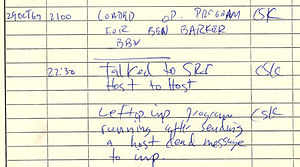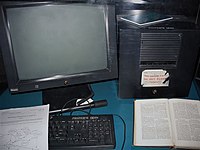User talk:Blakehockley
| The Internet | |
|---|---|
 |
Ruth Zanker's TV Craft Group presents a brief history of the Internet. On this page you will find the collection of a variety of sources that describe the history of the Internet. The Internet is an invention which has dramatically changed life on Earth, and has also created huge change within our traditional media industries, such as radio, television, and journalism.
Beginnings as ARPANET
[edit]1959: The Advanced Research Projects Agency (ARPA) was formed within the Pentagon to establish an American lead in military science and technology. To this end, a system was needed that could keep government control and communication functioning in the event of a nuclear attack, even if the centres of control were many hundreds of miles from each other. The result was ARPANET.

Vinton Cerf, a program manager at the Pentagon, and others, published their first proposals for protocols that would allow computers to 'talk' to each other. ARPANET began operating Network Control Protocol (NCP), the first host-to-host protocol. The grandfather of the Internet was born on 10.30pm, October 29th, 1969, when a message was sent successfully from one computer to another. Using what Davies termed a packet-switching process in order to secure the survivability of military command and control systems.
To secure this survivability, the network used a method of data transfer known as 'packet switching'. Packet-switching relied on a peer-to-peer computer networks in which all the computers on a network had equal status and data-forwarding capabilities. The transmitting computer would break up the data in small packets measuring only a few bytes. Packets were unique: all contained information as to their point of origin – destination on the network. They also had information which would enable the computer on the receiving end to reassemble the data set as soon as all packets had arrived.
The idea was to have an underlaying protocol taking care of establishing and maintaining communication between the computers on the network and a set of protocols which performed tasks such as remote login (telenet) and file transfers (FTP) and on top of this basic communications protocol, initially termed NCP (Network Control Protocol). Before long, parts of ARPANET began to resemble the Internet we have today, such as the introduction of electronic mail in October 1971, and a transatlantic connection in 1973.
USENET and other precursors of the Internet
[edit]It soon became clear that the military-focused ARPANET had many potential applications, and that it could be useful in many situations. To that end, USENET was created in 1979 by Tom Truscott and Jim Ellis at Duke University. USENET was a discussion forum, distributed amongst a variety of academic institutions via modems and phone lines. Imagine it as a hybrid between email and the internet forums many of us use today. Discussions were threaded, and placed in categories known as 'Newsgroups'.
Between 1982 and 1984, USENET connections were established in several European countries and Australia. Because USENET could use ARPANET connections, which had been funded by the American government, and there were also cheaper, alternative connections available, USENET spread extremely quickly and soon became extremely popular all over the world. Just ask Brian Pauling!
If ARPANET was the grandfather of the Internet, USENET was the father of it. Progress toward the familiar Internet we know today was swift, and all that was needed now was a catalyst.
The World Wide Web
[edit]That catalyst came from a young scientist, Tim Berners-Lee, who was working at the CERN Particle Physics laboratory in Switzerland. Physicists around the world were struggling to share masses of data with one another - USENET had no presentation functions, and it was also too slow to support the types of data that physicists needed to use. Berners-Lee set about to create a system to build on the Internet, known as 'Hypertext', which would allow information on the Internet to be easily linked, allowing users to link to any information, anywhere it might be stored. Berners-Lee collaborated with Robert Caillau, and created the tools that power the modern Internet - the HyperText protocol (HTTP), the HyperText Markup Language (HTML), the first web browser (WorldWideWeb), the first server software, and, finally, the first web pages that would be accessible to users. The browser was also able to access USENET groups, so it immediately provided access to huge amounts of information.
On August 6, 1991, Tim Berners-Lee posted a short message to the alt.hypertext newsgroup on USENET, and the World Wide Web became accessible for the first time.

"The WorldWideWeb (WWW) project aims to allow all links to be made to any information anywhere. [...] The WWW project was started to allow high energy physicists to share data, news, and documentation. We are very interested in spreading the web to other areas, and having gateway servers for other data. Collaborators welcome!"
Contributors poured in, and, by 1993, the first fully graphical, multi-platform web browser, 'Mosaic', was freely available thanks to US government funding. The World Wide Web and the Internet took off like a rocket. Annual web browser usage growth was 341,634%. Modem speeds rapidly increased to around 56kbits/sec, the maximum for the copper wire infrastructure around the world.
Services such as 'amazon.com' appeared in 1994, which foreshadowed the period from 1996 onwards, where by the Internet became increasingly commercialized, leading to some spectacular e-commerce successes and failures, leading to the 'dot-com boom'. By 1996, the number of commercial sites on the Internet outnumbered government and educational sites.
The bubble created by large amounts of venture capital and huge interest in the internet burst in 2001, leaving many companies bankrupt. However, many of today's well known internet services survived the bust, such as Google, Amazon, and Yahoo!.
Broadband and Web 2.0
[edit]One of the important aspects of the Internet that Berners-Lee acknowledged in 1991 was that it was a 'read-only' interface. You could look at data on the internet, but you couldn't change it. While users could write their own content, HTML code was potentially extremely complex, and required exact use of correct syntax to function properly. Thus, during the 1990s, the amount of user-created, professional quality information on the internet was fairly low.
The introduction of Broadband internet in the early 2000s (primarily through a technology known as ADSL in New Zealand) greatly increased the available speeds of internet connections around the world, resulting in a huge potential for new types of content to be shown on the Internet. Pictures, instead of taking minutes, took seconds. You could put video internet for the first time.
A result of the new abilities enabled by Broadband was arguably the introduction of Web 2.0 services. Web 2.0 describes services that allow users to create and share their own data. Content creation tools were born. Blogging tools, such as Blogspot and Blogger, are noticeable examples. People were able to mix and share the content they saw on the internet as well, with services such as StumpleUpon, Reddit, and Digg. Peer-to-peer file sharing, the bane of the music companies, became extremely popular through services like Napster. The focus of content is on the user - rather than the platform. (Sounds a bit like the media industry today, doesn't it?)
The Future: Web 3.0
[edit]And we're not done yet. Many people are already discussing and implementing 'Web 3.0', which comprises many of the new technologies in the world today, including Augmented Reality, The Cloud, and a focus on mobile delivery - a move away from the computer as we know it. Web 3.0 is also known as the Semantic Web, which seeks to make some sense of the huge amount (24 billion or so) webpages on the World Wide Web today, and provide a massive, interlinked network of information, available to everyone. There is a huge focus on individualising content, and tailoring it to an individual. Some even hypothesise that the true 'Web 3.0' won't really require much work from the user, rather than the user moving to the search engine, the search engine will move to the user, tailoring results to the user's individual tastes and preferences.
Another aspect of Web 3.0 is the wealth of services it provides. Web sites are no longer 'sites', they are 'services'. Helen Baxter, MD of Mohawk Media, cites a number of these websites, including Qik, TeamWorkPM, Hootsuite, and others, as examples of web services made possible by Web 3.0, because they allow users to create and have information tailored to their interests.
And this is just the beginning: many are already discussing a convergence of all the internet platforms for 'Web 4.0', expected to be delivered by 2020.
References
[edit]- http://inventors.about.com/library/weekly/aa091598.htm
- http://www.icann.org/en/biog/cerf.htm
- http://searchunifiedcommunications.techtarget.com/definition/Internet-Protocol
- http://www.arpa.net/
- http://public.web.cern.ch/public/
- http://www.w3.org/People/Berners-Lee/
- http://www.learnthenet.com/english/html/03future.htm
- http://www.connected-earth.com/Galleries/Frombuttonstobytes/ComputerNetworks/DevelopmentoftheInternet/index.htm
- http://www.vissing.dk/inthist.html
- http://www.elon.edu/predictions/internethistory.aspx
- http://www.vodafone.com/flash/receiver/11/articles/index00.html
![]() Hey there Blakehockley, thank you for your contributions. I am a bot, alerting you that non-free files are not allowed in user or talk space. I removed some files I found on User talk:Blakehockley. In the future, please refrain from adding fair-use files to your user-space drafts or your talk page.
Hey there Blakehockley, thank you for your contributions. I am a bot, alerting you that non-free files are not allowed in user or talk space. I removed some files I found on User talk:Blakehockley. In the future, please refrain from adding fair-use files to your user-space drafts or your talk page.
- See a log of files removed today here.
- Shut off the bot here.
- Report errors here.
Thank you, -- DASHBot (talk) 05:03, 26 May 2011 (UTC)
